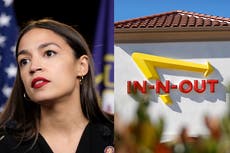In-N-Out owner reveals where ‘animal style’ name comes from
‘Animal Style’ burgers have become part of the permanent menu under the ‘not so secret menu’ category
In-N-Out’s classic “animal style” burger and fries used to be a secret menu item at the fast food chain, but has since become one most customers are now familiar with.
The option became so popular that it is now listed under the “not so secret menu” category on In-N-Out’s website. As for what it entails, “animal style” refers to a burger with a beef patty grilled with mustard then served with pickles, lettuce, grilled onions, and extra spread on a toasted bun. Animal style fries, meanwhile, are topped with cheese, spread, and grilled onions.
Although part of the menu, it wasn’t previously clear where the name for the burger joint’s style came from, until now.
Lynsi Snyder, one of the owners of In-N-Out, is sharing the chain’s secret, and other unknown details about the restaurant, in her book set to come out in October titled, The Ins-N-Outs of In-N-Out Burger: The Inside Story of California’s First Drive-Through and How it Became a Beloved Cultural Icon.
According to Insider, which received an advance copy of Synder’s book, one of the sections is called “Birth of Icons,” in which Synder discussed how the “animal style” burger was named.
It turns out that animal comes from rowdy customers or “animals.” Snyder wrote that these customers “would honk their horns while orders were taken,” or they would “leave trash on the lots and play their music extra loud”.
According to Syner, they were sometimes so rowdy they would get into fights with each other.
At the time, employees at In-N-Out were called “helpers” who began to call these customers “animals.”
“Good naturedly, the helpers inside referred to them as ‘animals,’” Snyder wrote.
She added that, one night in 1961, an “animal” spotted a manager making himself a burger. The joint was originally designed with floor-to-ceiling windows so customers could watch burgers being prepared, which was co-founder Harry Snyder’s idea, as he “believed customers would enjoy seeing their food made with care,” Snyder explained.
The customer was intrigued as to what this burger was and asked him what was in it. “It’s mustard fried,” Roberts responded, according to the book. “I add pickles, grilled onions, and extra spread.”
In response, the customer said: “Sounds amazing. Can you make me one too?” according to the book. Roberts obliged, and “the guy wolfed it down,” calling it the best burger he ever had, Snyder wrote.
The customer liked it so much that he continued to order it, but had no idea what to call. Eventually Roberts told him, “Just call it Animal Style,” according to Synder.
“That’s how Animal Style burgers got their name, and the request is the first known instance of a secret In-N-Out menu item,” Snyder wrote.
Today, this style is a popular way to not only order burgers, but fries as well. Synder wrote that the case for other items on the “not so secret menu” comes from custom creations customers have come up with over the years.
For example, the Double-Double was a custom “double meat, double cheese” off-menu order made by guests looking for a meatier meal, Snyder wrote. The Double-Double first appeared on the menu during the 1 August 1966 opening of store number six, according to the book.
Join our commenting forum
Join thought-provoking conversations, follow other Independent readers and see their replies
Comments


Bookmark popover
Removed from bookmarks